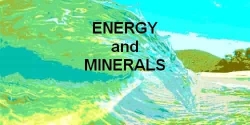Breccias - types. origins, distinguishing features
Breccias - types, origins, distinguishing features
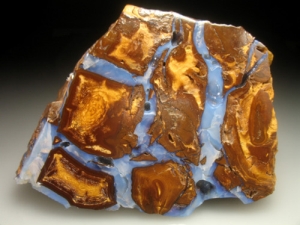
Classification of
Breccias...
Instrusive Breccia
Volcanic Breccia
Phreatomagmatic
Breccia
Magmatic-Phreatic Breccia
Phreatic Breccia
Tectonic Breccia
Sedimentary Breccia
Impact Breccia
Explosive Breccia
The diagnosis of a breccia
A very
simplified key to breccia origins
Describing Breccias
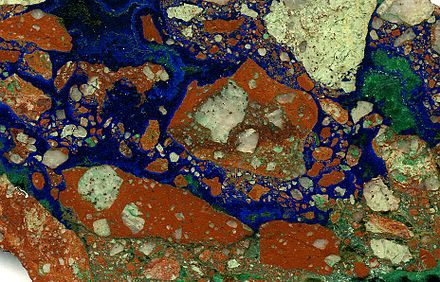
This page will try to answer the question... "What simple features can you look for that might give you an insight into how a particular breccia was made?"
Breccias are very important host rocks for mineralisation, not only because,of the large surface area they make available for water-rock interaction and the fact that they represent zones of high permeability, but some of the processes of brecciation such as hydraulic fracturing can closely related to the process of mineralisation. Classification is based on the proportions of vein clast, rock clasts, chemically deposited cement, and clastic / igneous matrix within the breccia
Knowing how a breccia originated can be very useful in understanding the geological landscape and history , the potential for economic mineralisation and via xenoliths / clasts give insights into hidden rock types...
Some terms that will help you understand fluids and gases that facilitate the formation of breccias...
- Meteoric water is the water derived from precipitation (snow and rain). This includes water from lakes, rivers, and icemelts, which all originate from precipitation
- Juvenile water has never been in the atmosphere. Original water, formed as a result of magmatic processes and is part of the molten rock. Magmatic water can form in very large quantities.
- Connate water is water trapped in the pores of a rock during formation of the rock. The chemistry of connate water can change in composition throughout the history of the rock.
- Fluids may contain water, dissolve gases (volatiles and dissolved solids (hot water under pressure can easily dissolve a large range of elements and compounds)
- Volatiles refer to gases dissolved in magmas, lavas and fluids - on the release of pressure these expand rapidly
Classification of Breccias...
Instrusive Breccias
These are subdivided into three members:- Magmatic-Intrusive-Breccias : – caused during the
emplacement of an intrusive body
– Consist of clasts comprising xenolith of country rocks, including previous intrusives,and fragment of early crystallised portion of the intrusive disrupted during emplacement, in matrix of crystalline igneous material – Frequently occur on the margins of intrusive bodies and contain clast of country rock in a crystalline igneous matrix
Intrusive Breccia
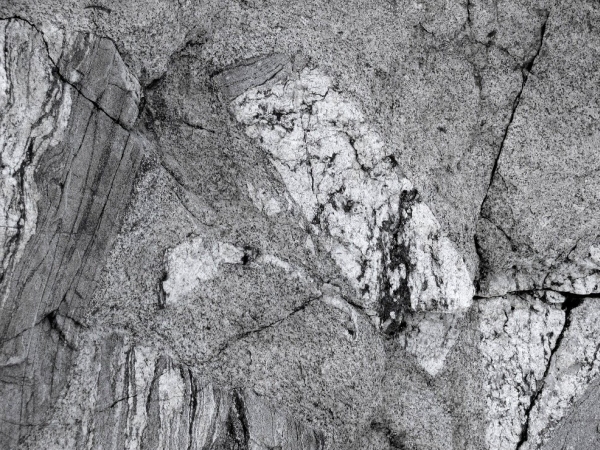
intrusive breccia with metamorphic xenoliths
- Magmatic-Hydrothermal Breccias - caused as an
intrusive body cools, the residual melt becomes increasingly
concentrated in volatile components, including water. As dissolved
gases are released from the magma, bubbles will begin to form. Bubbles
frozen in a porous or frothy volcanic rock are called vesicles, and
the process of bubble formation is called vesiculation or gas
exsolution. The dissolved gases can escape only when the vapor
pressure of the magma is greater than the confining pressure of the
surrounding rocks. The vapor pressure is largely dependent on the
amount of dissolved gases and the temperature of the magma.
Explosive eruptions are initiated by vesiculation, which in turn, can be promoted in two ways:
(1) by decompression, which lowers the confining pressure, and
(2) by crystallisation, which increases the vapor pressure.
In the first case, magma rise can lead to decompression and the formation of bubbles, much like bubbles form when you open a can of soft drink. This is sometimes referred to as the first boiling.
Alternatively, as magma cools and anhydrous minerals begin to crystallize out of the magma,the residual liquid will become increasingly enriched in gas. In this case, the increased vapor pressure in the residual liquid can also lead to gas exsolution. This is sometimes referred to as second (or retrograde) boiling. Both mechanisms can trigger brecciation.
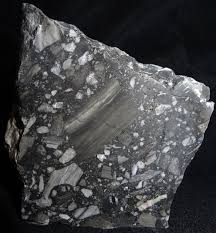
- Magmatic-Tectonic Breccias - caused when intrusive is
forcefully emplaced, especially if it is viscous or substantially
subcrystalline, it may cause fracturing of the surrounding
formation during emplacement, giving a magmatic - tectonic
breccia. The essential feature is that it has formed by deformation
associated with the emplacement of an intrusive, rather than by
regional faulting but is of mechanical rather than due to hydraulic
fracturing. The geological relationships of the breccia to the
intrusive body offer the opportunity to identify magmatic tectonic
breccias since texturally they are very similar to other tectonic
breccias
magmatic-tectonic breccia...

magmatic-tectonic breccia clast size decreases as you get towards the solid rock...
Volcanic Breccias
caused by the release of pressure by magmatic volatilesDivided into two sub-types:
- Endogenous Volcanic Breccias (non-eruptive or vent breccias)
- - example - sub-surface equivalent explosion breccia
Sub-volcanic Breccia
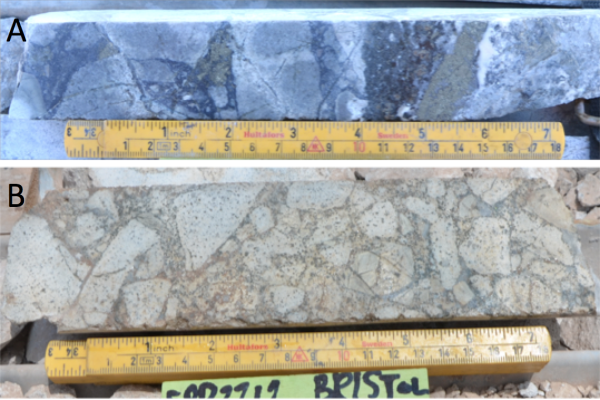
sub-volcanic breccia shattered insitu sub-surface
- Exogenous (Eruptive) ie. Volcanic Breccias - example
fragmental breccias
Pyroclastic Breccia
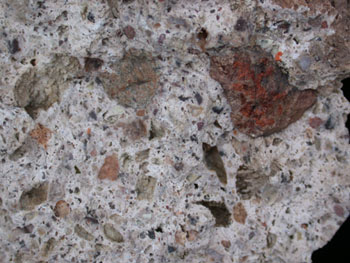
pyroclastic breccia - shattered erupted fragments in a matrix of volcanic ash
Phreatomagmatic Breccias
caused when upwelling magma encounters water. This may be groundwater, connate water or a body of surface water.These breccias divide into:
- .Endogenous (noneruptive) phreatomagmatic breccias
-example diatremes
Diatreme - an explosion breccia
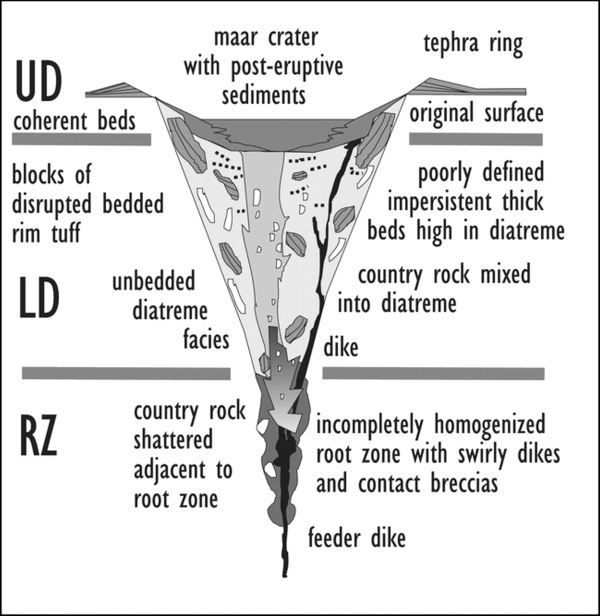
in a diatreme a gaseous explosion flings shattered rock into the air to fall back into the pipe randomly arranged but often with block size grading finer upwards (ie the largest blocks fall back first)
- Exogenous (eruptive) - example venting to surface
Magmatic-Phreatic Breccias
Caused by the flashing (ie steam and gas separation) of a fluid which is composed of water or steam which may contain a proportion of magmatic volatiles but is predominantly of meteoric, groundwater or connate origin and which has been directly heated by the intrusion of magma and where the resulting breccia does not contain juvenile magmatic products.The difference between a phretomagmatic breccia and a magmatic-phreatic breccia is that the former includes juvenile magma (as distinct from magmatic volatiles) wheras the latter does not.
Divided into :
- Edogenous (non-eruptive) Magmatic-Phreatic Breccias
- Exogenous (eruptive) Magmatic-Phreatic Breccias
Phreatic Breccias
caused by the expansion of steam or gas from a water-dominated fluid with only a minor component of magmatic volatiles and that the mechanism of energy transport to the focus of the brecciation has to be at some point by free-convecting column of sub-critical hydrous fluid, though the process may involve flashing (steam and gas phase separation) It also includes hydraulic fracturing of the containing formations by hydrothermal fluidsHydrothermal breccias are usually formed by hydrofracturing of rocks by highly pressured hydrothermal fluids. Hydrothermal breccias usually form at shallow crustal levels (<1 km) between 150 to 350 °C, • when seismic or volcanic activity causes a void to open along a fault deep underground. The void draws in hot water , and as pressure in the cavity drops, the water violently boils . In addition, the sudden opening of a cavity causes rock at the sides of the fault to destabilise and implode inwards, and the broken rock gets caught up in a churning mixture of rock, steam and boiling water. Volatile gases are lost to the steam phase as boiling continues, in particular carbon dioxide . As a result, the chemistry of the fluids changes and ore minerals rapidly precipitate. Breccia- hosted ore deposits are quite common.
Divided into :
- Endogenous Phreatic Breccias
- Exogenous Phreatic Breccias - Explosion Breccia
Tectonic Breccias
Tectonic are formed by the mechanical disruption rocks in response to tectonic stress. Mechanical disruption of rocks in response to tectonic stress. Mechanical disruption may grind clasts to rock flour forming gouge or mylonite. Tectonic breccias tend to occur in identifiable, usually steeply dipping fault planes. If a large enough .exposure is available in outcrop or in a drill hole, tectonic be seen to lie between two different rock types, on either side of the fault (though this can be misleading as phreatic breccias also commonly follow lithologic contacts or fault planes).Fault Breccia... In fault zones, where rocks or even continents slide past each other, breccia zones can be created that can vary from inches across to tens of meters across. Fault breccia results from the grinding action of two fault blocks as they slide past each other. Subsequent cementation of these broken fragments may occur by means of the introduction of mineral matter in groundwater
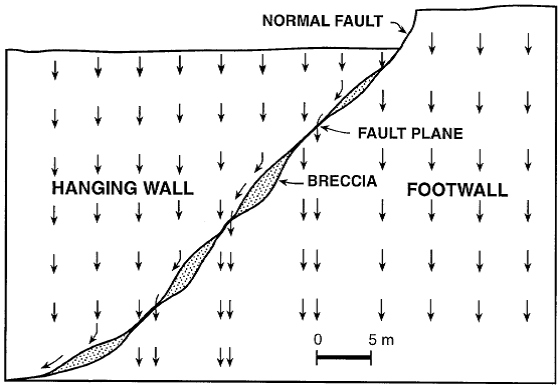

dilation and shear cause a fault breccia
Stages in formation of fault breccia...
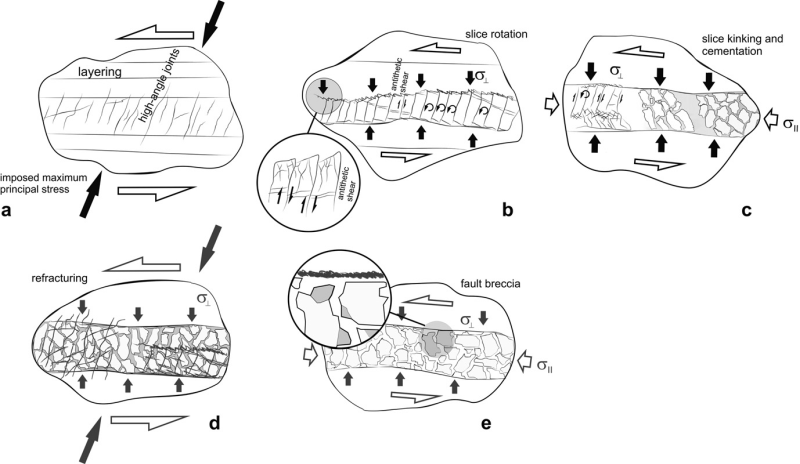
Fold Breccia ...
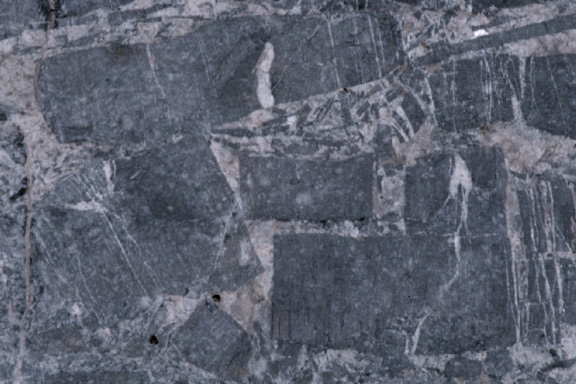
"blockyness" typical of a fold breccia, note... veins are still nearly aligned as brittle bed fragments
Hydrothermal Fluid Inclusion Breccias (Pipe and Vein Style Pebble Dykes) caused by the mechanical disruption of rocks in response to tectonic stress.
May grind clasts to rock flour forming gouge or mylonite
Fluid inclusion breccia - mylonite...
tectonic "grinding" causes mylonite
Tectonic breccias are major importance for mineralisation in metamorphic terraines. Tend to occur in identifiable, usually steeply dipping, fault planes
If mineralisation is associated with a tectonic breccia in non-metamorphosed volcanic terrain,it is unlikely that the tectonism caused the mineralisation,and so the function of the breccia is probably just to provide permeable path for mineralsing fluids.
Exploration strategy should consist of tracking the extent of the breccia, and separately interpreting the mineralising process
If mineralisation appears to have pre-dated faulting, the possibility of concealed cut-off mineralised zone should be considered.
Sedimentary Breccias
caused by predominantly sedimentary processes...Sedimentary breccia is a type of clastic sedimentary rock which is made of angular to subangular, randomly oriented clasts of other sedimentary rocks. • Sedimentary breccias comprise more than 30% gravel-size (>2mm) angular clasts produced by mechanical weathering or brittle deformation of nearby rocks. Their angular shape implies minimal transport. Breccia vs conglomerates
In the typical epithermal / porphyry environment, they consist principally of volcanic material volcaniclastic sediment range from epiclastic deposits such as laharic or avalanche deposit , that have little evidence of sedimentary processes, through to well-sorted volcanogenic sandstones or pumicities
The essential feature of these breccias is that they have been emplaced on the earth’s surface by predominantly sedimentary processes.
Sedimentary breccia showing sorting

sedimentary breccia - vertical sorting of clasts by settling
Features:
- indicative of water transport may be apparent, such as crossbedding.
- there may be interbedded non-volcanogenic sediments
- mineralisation in this setting is not directly related to brecciation processes
Sedimentary breccia as the result of a debris flow...
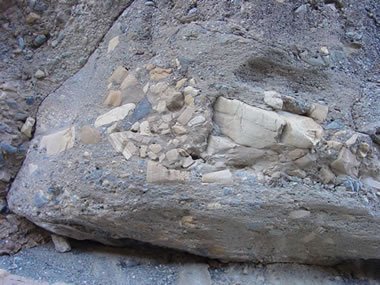
debris flow breccia - no sorting of clasts due to flash flood conditions
Collapse breccia in sedimentary sequence
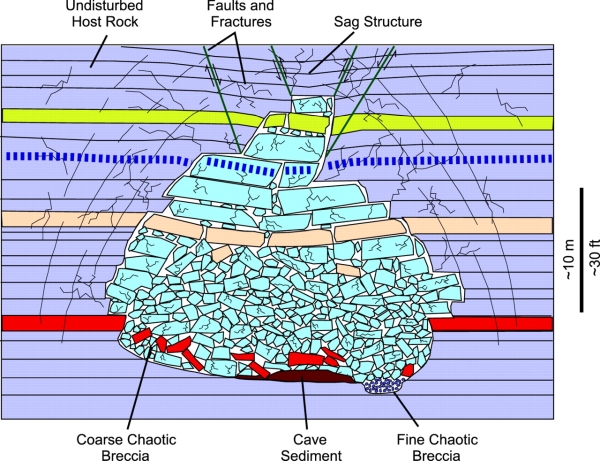
collapse breccias keep the sequence of stratigraphic beds
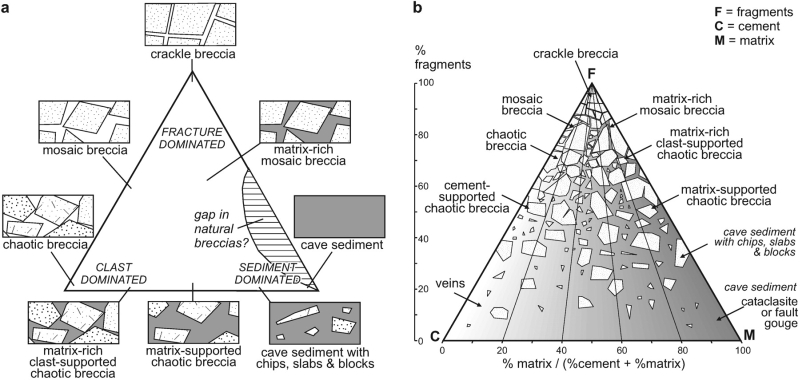
Impact Breccia
An impact breccia is “a breccia with clastic matrix or crystalline matrix (derived from the crystallization of impact melt) containing lithic and mineral clasts of different degree of shock metamorphism excavated by an impact from different regions of the target rock section, transported, mixed, and deposited inside or around an impact crater or injected into the target rocks as dikes”. Impact melt-breccias form by the fracturing and fusion of rocks under extreme pressures and temperatures rapidly induced during meteorite impacts. Breccia of this type may be present on or beneath the floor of the crater, in the rim, or in the ejecta expelled beyond the crater. Impact breccia may be identified by its occurrence in or around a known impact crater, and/or an association with other products of impact cratering such as shatter cones, impact glass, shocked minerals, and chemical and isotopic evidence of contamination with extraterrestrial material (e.g. iridium and osmium anomalies).Impact breccia showing red "heated" limestone...

Impact breccia showing rock fragments melted to "glass"...
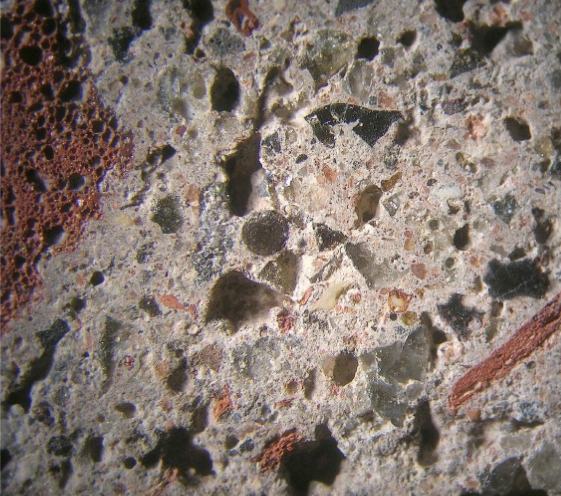
Wet impact Breccia...
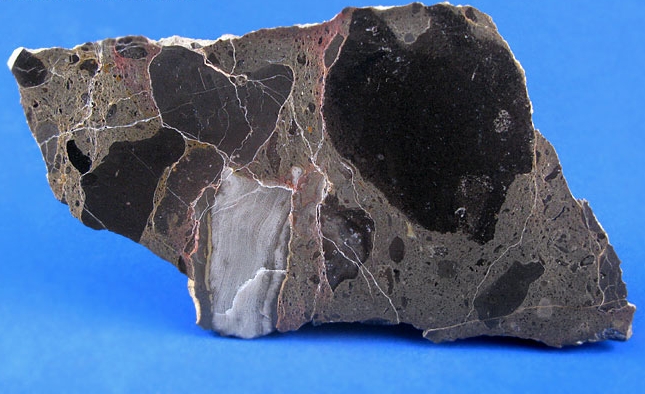
Wet impact breccia caused when a meteorite crashed into a warm shallow sea, rich in coral.
Note the angular fragments which have been shattered by the force of impact.
The white inclusion, bottom left, is fossilized coral from the ancient reef.
Explosive Breccia
Explosive brecciation which occurs beneath the surface of the earth is not exclusively a near-surface phenomenon, nor related to a unique igneous type.A common feature is the presence of volatiles in the associated plutonic and hypabyssal masses and explosive activity is related to the sudden release of gas which occurs when gas charged magma moves into zones of fractured rock.
Variation in gas pressure, including rhythmic variation, is indicated by the mineral content of the igneous masses, many of which have alkaline affinities.
Structural control of the sites of explosion-breccia pipes is common and the formation of intrusive breccias, in which the process of fluidisation is prominent, may follow the explosive breaching of structural traps.
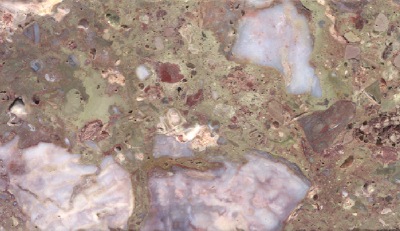
The bluish-white clasts are shards of sinter that were dislodged in the hydrothermal explosion
The term explosion breccia has been used to describe breccias formed as the result of explosion beneath the surface of the earth in which there was little movement of the blocks away from their original positions. In many instances blocks formed as the result of explosion have been moved considerable distances in the crust by the subsequent action of gases or liquids, giving rise to masses of intrusive breccia. This is a genetic sequence which is completely gradational and in which it is impossible to draw a significant dividing line.
Therefore 'explosion-breccia" is used here as a generic descriptive tern: while at the same time recognising that many of the breccia masses may show intrusive relations.
many parts of the world (WRIGHT and BOWLS, 1963) and the variety of igneous rock types and suites with which they are associated may be grouped as follows:
- Appinite, felsite, syenite and diorite masses cut well developed explosion-breccia pipes
- The alkaline olivine-basalt volcanic suite has, in some cases, associated explosion-breccia pipes, dykes and veins while the genetically related group of nepheline syenites and carbonatites are commonly found as plugs which intrude explosion-breccia masses Plugs and dykes of alkaline lamprophyres, which show petrographic features similar to the alkaline olivine-basalt volcanic suite, also have associated explosion-breccia pipes
- Kimberlites, which are usually regarded as intrusive breccias of igneous parentage
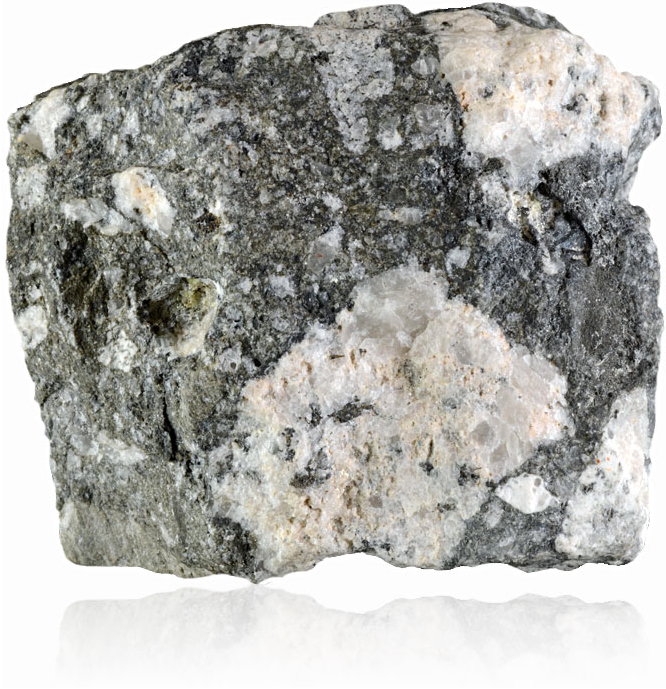
The diagnosis of a breccia
requires the close observation of its most intimate characteristics as well as of its associations with the adjacent rocks. The matrix may be like or unlike the fragments lithologically. It may be a chemical precipitate, a sedimentary deposit, or the detritus of attrition. In volume it may be greater or less than the fragments — interstitial, merely filling the spaces between the fragments closely packed, or preponderant, forming the larger part of the rock-mass in which the fragments are sporadic. The fragments may be of any size, from huge blocks down to chips.Lithologically they may be similar or dissimilar, according as they result from the fragmentation of a homogeneous rock-mass or from that of heterogeneous beds. They may be sharply angular, more or less rounded by attrition in earth movements, or even in part water-worn and approaching a conglomerate.
They may be local in derivation, produced by the breaking up in situ of a terrane, or they may have suffered transportation from distant sources. They may be simple or of complex and brecciated structure, the result of an earlier brecciation.
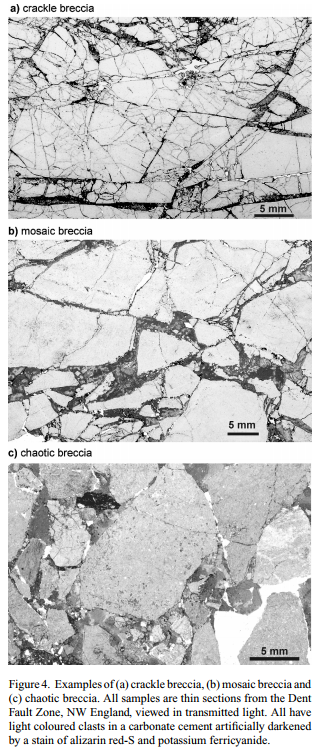
Breccia may form a mass entirely destitute of planes of bedding. When bedded in a distinct stratum it may be classified as endostratic. A crackle breccia, representing incipient brecciation, is one whose fragments are parted by planes of fission and have suffered little or no relative displacement. The fragments match along their apposed sides. The matrix is confined to the seams and is commonly a chemical deposit.
A mosaic breccia is one whose fragments have been largely but not wholly disjointed and displaced. The system of continuous cracks of the crackle breccia has been destroyed, but more or less of the fragments still match along adjacent surfaces and show that they are consanguineous parts of once unbroken laminae or larger beds. The term suggested is not a happy one, yet these breccias may recall some ill-preserved mosaics of ancient ruins. The matrix is confined to the seams and to the wider and irregularly shaped interstices.
A rubble (chaotic)breccia is one in which no matching fragments are parted by initial planes of rupture. The fragments are close-set and in touch.
A very simplified key to breccia origins

Describing Breccias
Class - breccia can be divided into two broad classes:- Clast supported - where the clasts touch each other and the matrix
fills the voids
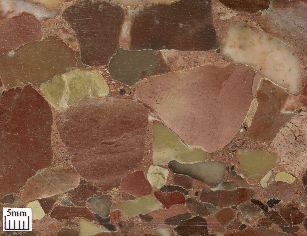
- Matrix supported - where the clasts are not in contact and the
matrix surrounds each clast
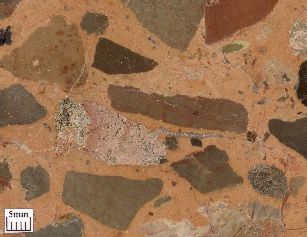
When describing breccias,the following feature should be noted:
- Clast lithologies
- The shape of clasts
- The size and size distribution(degree of sorting)of the clasts
- Alignment,imbrication,or grading,and any textures such as: “ flow structures” are apparent in the matrix
- Whether the breccia is clast supported or matrix suppported
- The ratio of clast to matrix;e.g.Jigsaw;crackle; breccias have a high cement ratio of clasts to matrix, but clasts are separately by a cement of secondary minerals, and are therefore matrix-supported
- The nature of matrix: crystallline, clastic, or igneous,and its mineralogy, and whether any open voids are present
- The relative timing of brecciation and veining.
- .If the breccia is altered or mineralised,where the matrix and clast seem to have been altered in the same way
- There could be more than one generation of brecciation
- Sufficiently large exposure is accessible
Descriptive Terms for Breccias
- Geometry eg . Pipe, cone, dyke, vein, irregular, tabular
- Contact - sharp, gradational, faulted, irregular, planar, concordant, discordant
- Grain size (clast)
Mud (1/16 mm)
Sand (1/16 - 2 mm)
Breccia / conglomerate
Fine grained (2 4 mm)
Medium grained (4 - 64 mm)
Coarse - grained (64 - 256 mm)
Very coarse grained (>256) - Component : Clasts
Matrix - Cement - Open space or vugs
Clasts Monomict or polymict
Lithology type - lithic (type), vein, breccia, juvenile magmatic, accretionary lapilli, pseudoclastic , mineralised, altered)
a)Morphology – angular, subangular , subround ( eg . Pipe, cone, dyke, vein, irregular, tabular)
b) Matrix - Rock flour, crystal fragments, lithic fragments, vein fragments, Open space or vugs, cement type
c)Texture – banded, laminated, massive
- Ore and gangue mineralogy, and grain size
Texture – e.g. cockade, massive, drusy
Crystalline igneous rock, open space or vugs
- Internal Organisation (outcrop scale features)
Clast abundance – clast/matrix/cement supported
Clast distribution – jigsaw - fit, insitu rotated, chaotic
Massive (non - graded) or graded
Clast sorting – by size and/or shape
Stratified or unstratified - Alteration
Clast/matrix/cement and paragenesis
http://www.wikiwand.com/de/Brekzie
http://www.steinheimer-becken.de/bilder_brekzie.html
https://researchonline.jcu.edu.au/47307/ Geology of the Mt. Leyshon gold deposit, Australia: a study of breccia pipe formation, facies and brecciation mechanisms Wormald, Peter John (1993) . PhD thesis, James Cook University of North Queensland.
https://archive.org/stream/jstor-30060966/30060966_djvu.txt
http://www.geociencias.unam.mx/~alaniz/Woodcock%20and%20Mort2008-Clasificacion%20fallas.pdf
https://structuredatabase.wordpress.com/fault-rocks/fault-breccia/
https://www.scribd.com/document/307065659/Hydrothermal-Breccia-Texture by 2016/3/31Analisis Batuan @ Rosana 20166
http://www.pitt.edu/~cejones/GeoImages/2IgneousRocks/IgneousTextures/9Pyroclastic.html
https://structuredatabase.wordpress.com/fault-rocks/fault-breccia/
http://geology.com/rocks/breccia.shtml
https://www.geothermal-energy.org/pdf/IGAstandard/NZGW/1990/Lawless.pdf

